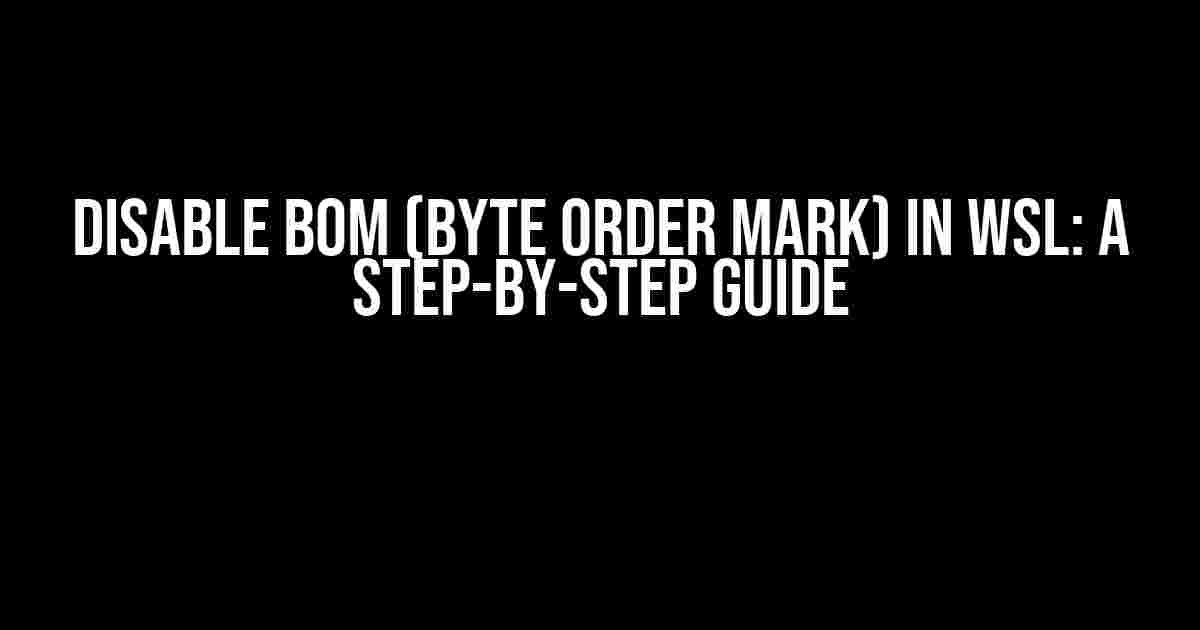Are you tired of dealing with the pesky Byte Order Mark (BOM) in your Windows Subsystem for Linux (WSL) environment? Do you want to know the secret to disabling it for good? Look no further! In this comprehensive guide, we’ll take you through the process of disabling BOM in WSL, and explain why it’s essential for a smooth development experience.
What is BOM, and why do I need to disable it?
The Byte Order Mark (BOM) is a 2- or 3-byte marker that indicates the encoding of a text file. It’s commonly used in Unicode files to specify the byte order of the characters. However, in the context of WSL, the BOM can cause issues with file encoding, leading to errors and inconsistencies in your code.
Disabling the BOM in WSL is crucial for several reasons:
- Ensures consistent file encoding: Without the BOM, your files will be encoded consistently, reducing the risk of errors and corruption.
- Improves compatibility: Disabling the BOM allows you to work seamlessly with other operating systems and development tools.
- Simplifies file transfer: When you disable the BOM, you can transfer files between systems without worrying about encoding issues.
How to disable BOM in WSL
Disabling the BOM in WSL is a straightforward process that requires only a few steps. Follow along, and we’ll have you BOM-free in no time!
Step 1: Open the WSL terminal
Open the WSL terminal by searching for “WSL” in the Windows search bar, or by typing “wsl” in the Command Prompt.
wsl
Step 2: Edit the bashrc file
Edit the bashrc file using your preferred text editor. We’ll use the nano editor in this example.
nano ~/.bashrc
Step 3: Add the encoding configuration
Add the following lines to the end of the bashrc file:
export LC_ALL=en_US.UTF-8
export LANG=en_US.UTF-8
export LANGUAGE=en_US.UTF-8
These lines set the language and encoding settings to UTF-8, which is the default encoding in WSL. This will ensure that your files are encoded correctly, without the BOM.
Step 4: Save and reload the bashrc file
Save the changes to the bashrc file and reload it using the following command:
source ~/.bashrc
Step 5: Verify the BOM status
Verify that the BOM has been disabled by running the following command:
file --mime-encoding file.txt
If the BOM has been successfully disabled, the output should indicate that the file is encoded in UTF-8, without the BOM.
Troubleshooting common issues
While disabling the BOM in WSL is a straightforward process, you may encounter some common issues. Don’t worry, we’ve got you covered!
Issue 1: The BOM is still present
If you’ve followed the steps correctly, but the BOM is still present, try running the following command:
chattr -i file.txt
This command will remove the immutable attribute from the file, allowing you to modify it and remove the BOM.
Issue 2: File encoding issues
If you’re experiencing file encoding issues, such as corrupted characters or unexpected behavior, try setting the encoding explicitly:
export LESSCHARSET=utf-8
This command sets the encoding for the LESS pager to UTF-8, which should resolve any encoding issues.
Conclusion
Disabling the BOM in WSL is a crucial step in ensuring a smooth development experience. By following the steps outlined in this guide, you’ll be able to work efficiently with files, without the hassle of encoding issues. Remember, a BOM-free WSL environment is a happy WSL environment!
FAQs
Got more questions? We’ve got answers!
| Question | Answer |
|---|---|
| What is the default encoding in WSL? | The default encoding in WSL is UTF-8. |
| Why do I need to disable the BOM in WSL? | You need to disable the BOM in WSL to ensure consistent file encoding, improve compatibility, and simplify file transfer. |
| Can I disable the BOM in WSL using other methods? | Yes, there are other methods to disable the BOM in WSL, such as using the `iconv` command or modifying the system settings. However, the method outlined in this guide is the most straightforward and efficient. |
Final thoughts
Disabling the BOM in WSL is a simple yet crucial step in ensuring a seamless development experience. By following the steps outlined in this guide, you’ll be able to work efficiently with files, without the hassle of encoding issues. Remember, a BOM-free WSL environment is a happy WSL environment!
Now, go ahead and disable that BOM! 🚀
- Share this article with your friends and colleagues to help them disable the BOM in WSL.
- Leave a comment below to ask any questions or share your experiences with disabling the BOM in WSL.
- Subscribe to our newsletter to stay up-to-date with the latest WSL tutorials and guides.
Frequently Asked Question
Get ready to dive into the world of WSL and conquer the Byte Order Mark (BOM) beast!
What is the Byte Order Mark (BOM) and why do I need to disable it in WSL?
The Byte Order Mark (BOM) is a 2-4 byte marker at the beginning of a file that indicates the byte order of the file. In WSL (Windows Subsystem for Linux), the BOM can cause issues with file encoding and interpretation. Disabling it ensures that your files are read and written correctly, avoiding potential conflicts and errors.
How do I disable the BOM in WSL?
To disable the BOM in WSL, you can add the following line to your `~/.bashrc` file: `export LC_CTYPE=C.UTF-8`. This sets the locale to C.UTF-8, which disables the BOM. Alternatively, you can use the `utf-8` encoding scheme in your editor or IDE, which also disables the BOM.
What if I’m using a specific text editor or IDE in WSL? Do I need to make changes there as well?
Yes, it’s a good idea to configure your text editor or IDE to use the `utf-8` encoding scheme without BOM. This ensures that your files are saved correctly, even when editing outside of the terminal. Check your editor’s settings or documentation for specific instructions on how to do this.
Will disabling the BOM affect the performance of my WSL environment?
No, disabling the BOM should not affect the performance of your WSL environment. The BOM is a file encoding marker, and disabling it only affects how files are read and written. It does not impact the overall performance of your system or applications.
Can I revert back to the default BOM setting if I need to?
Yes, you can easily revert back to the default BOM setting by removing the `export LC_CTYPE=C.UTF-8` line from your `~/.bashrc` file or adjusting your editor’s settings. This will restore the default BOM behavior in WSL.


